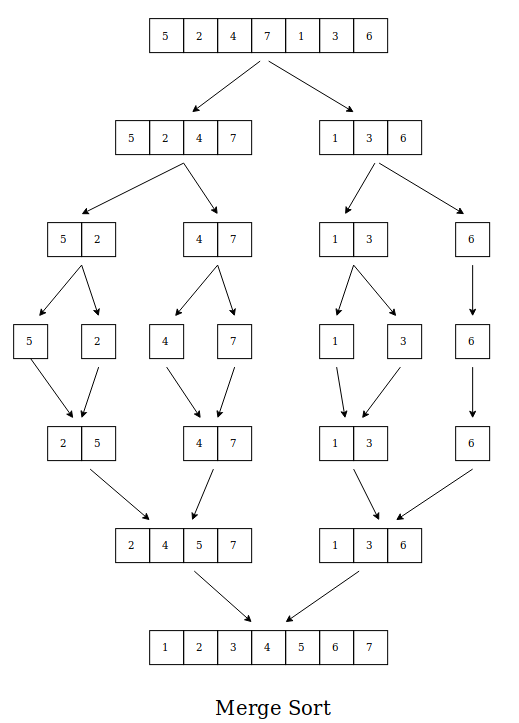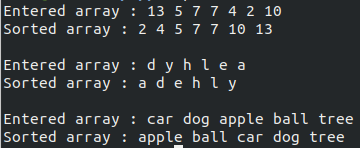Merge Sort | C++ Implementation
Merge sort follows divide-and-conquer approach. It divides an array of n elements into two subarrays of n/2 elements each. Then it sort the two subarrays recursively using merge sort. And then these subarrays are merged to produce a single sorted array.

If the size of the array is even then the size of subarrays is equal and if it is odd then first array has one element more than the second array. The division of array stops when subarrays contain only one element and then merging of subaarrays starts. The arrays are merged in sorted order.
Here is the generic implementation of merge and merge_sort function. It sorts array of all datatypes.
template<class T>
void merge(std::vector<T>& v, int p, int q, int r)
{
int size1 = q-p+1;
int size2 = r-q;
std::vector<T> L(size1);
std::vector<T> R(size2);
for(int i = 0; i < size1; i++)
{
L[i] = v[p+i];
}
for(int j = 0; j < size2; j++)
{
R[j]=v[q+j+1];
}
int i=0,j=0;
int k;
for(k = p; k <= r && i < size1 && j < size2; k++)
{
if(L[i] <= R[j])
{
v[k] = L[i];
i++;
}
else
{
v[k] = R[j];
j++;
}
}
for(i = i; i < size1; ++i)
{
v[k] = L[i];
k++;
}
for(j = j; j < size2; j++)
{
v[k] = R[j];
k++;
}
}
When merge function is called, two auxiliary vectors L and R are created. L is initialised with elements of left subarray and R is initialised with elements of right subarray. Both subarrays contain one element each. For eg. from the above fig. L contains 5 and R contains 2.
When we merge these subarrays, the smallest element from these subarray is selected and the element is entered in the input array v at index 0. k maintains the index of input array and i and j maintains the index of L and R subarrayarray respectively.
If all the elements of one of the subarray are entered then remaining elements of the another subarrays are entered in the input array since all elements are greater than the last input value. This is done with the help of last two for loops in the above function.
template<class T>
void merge_sort(std::vector<T>& v, int p, int r)
{
if(p < r)
{
int q = (p+r)/2;
merge_sort(v, p, q);
merge_sort(v, q+1, r);
merge(v, p, q, r);
}
}
merge_sort recursively calls itself until r is smaller than or equal to p.
Here is the output of merge sort with generic functions.

#include <iostream>
#include <vector>
template<class T>
void merge(std::vector<T>& v, int p, int q, int r)
{
int size1 = q-p+1;
int size2 = r-q;
std::vector<T> L(size1);
std::vector<T> R(size2);
for(int i = 0; i < size1; i++)
{
L[i] = v[p+i];
}
for(int j = 0; j < size2; j++)
{
R[j]=v[q+j+1];
}
int i=0,j=0;
int k;
for(k = p; k <= r && i < size1 && j < size2; k++)
{
if(L[i] <= R[j])
{
v[k] = L[i];
i++;
}
else
{
v[k] = R[j];
j++;
}
}
for(i = i; i < size1; ++i)
{
v[k] = L[i];
k++;
}
for(j = j; j < size2; j++)
{
v[k] = R[j];
k++;
}
}
template<class T>
void merge_sort(std::vector<T>& v, int p, int r)
{
if(p < r)
{
int q = (p+r)/2;
merge_sort(v, p, q);
merge_sort(v, q+1, r);
merge(v, p, q, r);
}
}
int main()
{
std::vector<int>vec;
vec.push_back(13);
vec.push_back(5);
vec.push_back(7);
vec.push_back(7);
vec.push_back(4);
vec.push_back(2);
vec.push_back(10);
int sz = vec.size();
std::cout << "Entered array : ";
for(int n = 0; n < sz; n++)
{
std::cout << vec[n] <<" ";
}
std::cout << "\n";
std::cout << "Sorted array : ";
merge_sort(vec, 0, sz-1);
for(int n = 0; n < sz; n++)
{
std::cout << vec[n] << " ";
}
std::cout << "\n\n";
std::vector<char> c;
c.push_back('d');
c.push_back('y');
c.push_back('h');
c.push_back('l');
c.push_back('e');
c.push_back('a');
int sz1 = c.size();
std::cout << "Entered array : ";
for(int n = 0; n < sz1; n++)
{
std::cout << c[n] <<" ";
}
std::cout << "\n";
std::cout << "Sorted array : ";
merge_sort(c, 0, sz1-1);
for(int n = 0; n < sz1; n++)
{
std::cout << c[n] << " ";
}
std::cout << "\n\n";
std::vector<std::string> str;
str.push_back("car");
str.push_back("dog");
str.push_back("apple");
str.push_back("ball");
str.push_back("tree");
int sz2 = str.size();
std::cout << "Entered array : ";
for(int n = 0; n < sz2; n++)
{
std::cout << str[n] <<" ";
}
std::cout << "\n";
std::cout << "Sorted array : ";
merge_sort(str, 0, sz2-1);
for(int n = 0; n < sz2; n++)
{
std::cout << str[n] << " ";
}
std::cout << "\n";
return 0;
}
Reference: Introduction to Algorithms The Algorithm Design Manual Data Structures and Algorithms Made Easy Competitive Programmer’s Handbook - Antti Laaksonen
Selection sort Insertion Sort Quicksort Heapsort